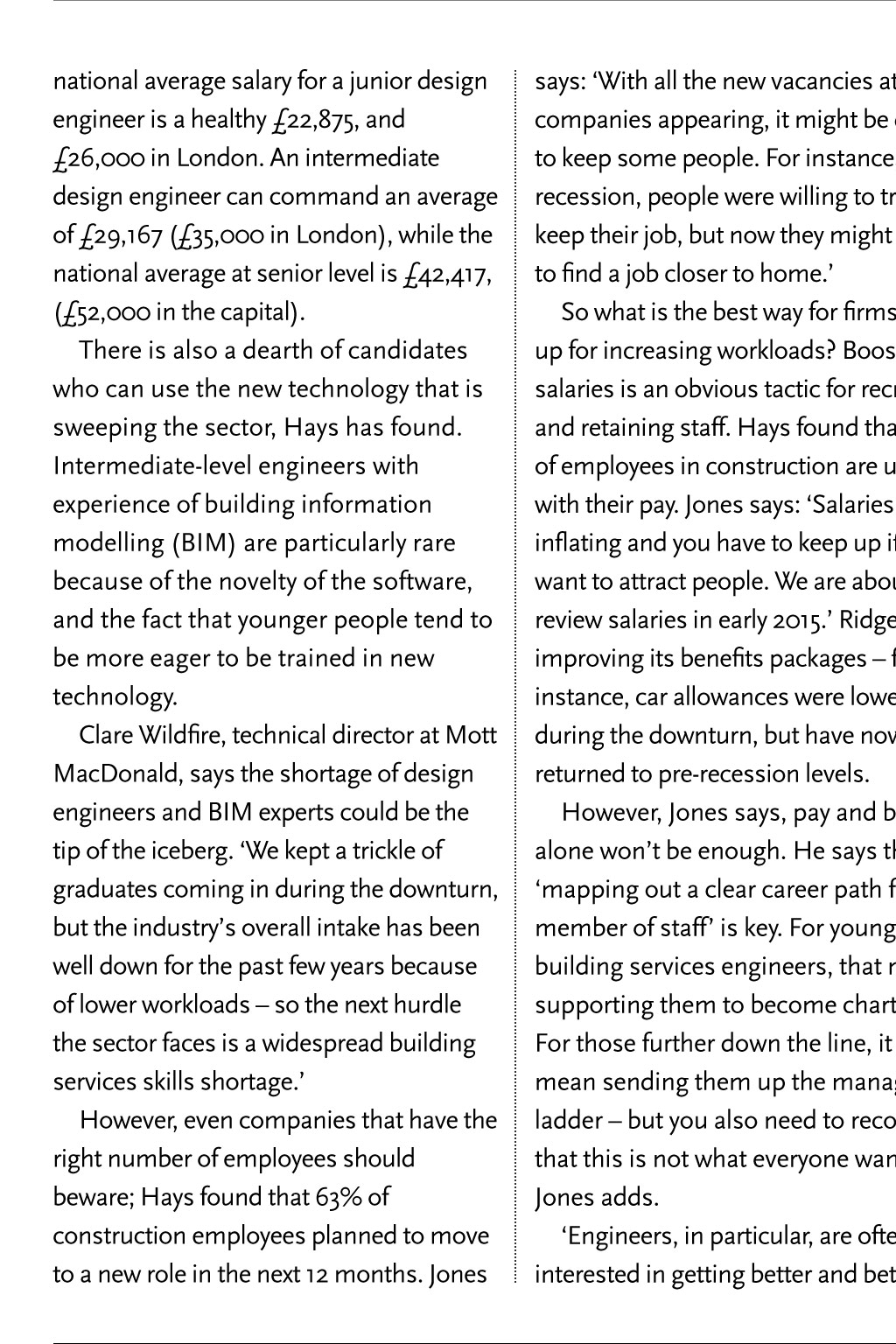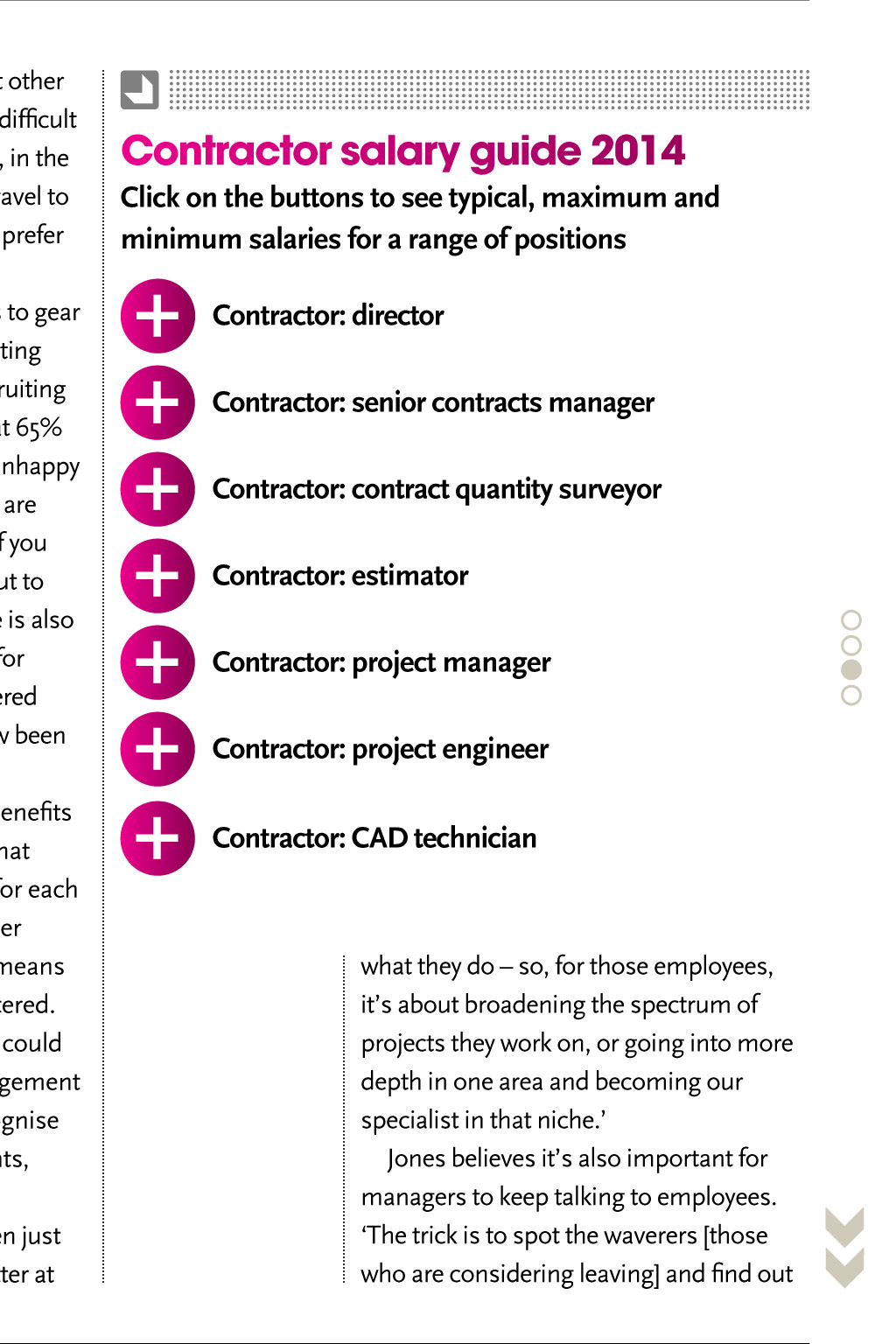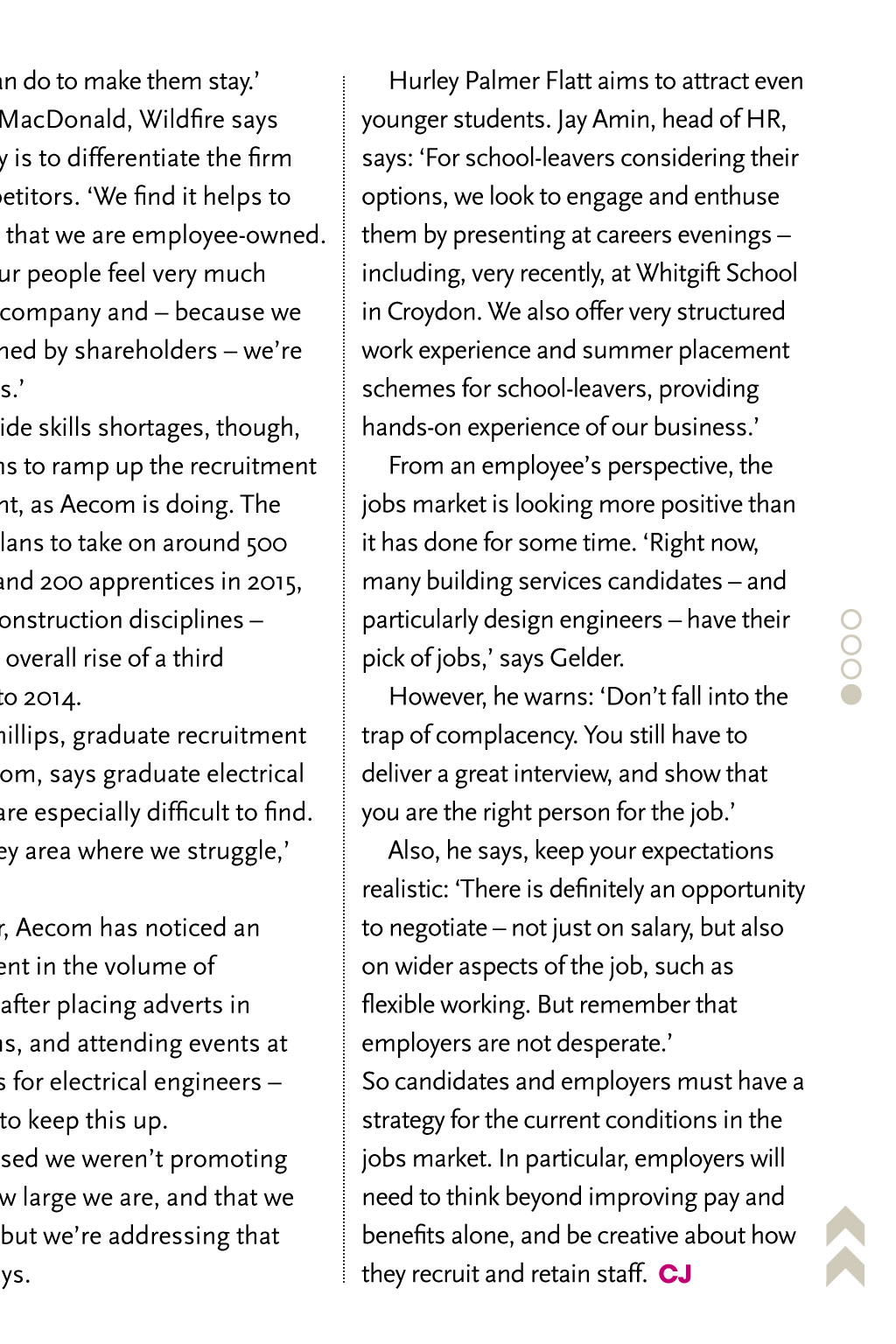
















PAY AND BENEFITS HAYS CAREERS SURVEY SCALING THE HEIGHTS Building services engineers are seeing their salaries rise, and those with BIM skills are attracting the highest premiums. Roxane McMeeken observes the peaks in the 2015 Hays Salary Survey A fter taking a long, swooping dive, the construction industry is swiftly pulling up and out of recession. The jobs market is reacting accordingly with more vacancies and intense competition for candidates but there are skills recovery and the attendant uplift in the jobs market? Richard Gelder, UK director for property disciplines at Hays Construction & Property, says: A year to 18 months ago, most firms in the sector were down to a skeleton staff, so even a small rise in construction activity would lead to recruitment. However since the third quarter of 2014 weve been seeing a clear surge in recruitment activity. Our building services salary guide, compiled exclusively for CIBSE Journal by Hays, bears this out. The findings based on candidates Hays has placed, and interviews with employees and employers revealed that 77% of construction industry bosses plan to recruit in the next 12 months. Another clear sign of confidence, Gelder adds, is that there are more employers looking for permanent recruits than seeking temporary members of staff. This is a reversal of the trend of recent years, where there was a preference for temporary roles. Gelder says there is a genuine and sustained increase in workloads in the sector. Indeed, evidence of recovery in the industry is widespread. For example, figures released in November, by the Construction Products Association, show that the third quarter of 2014 was the industrys sixth consecutive quarter of growth. Around 60% of contractors, of all sizes, reported increased activity in Q3 2014, across all sectors apart from private housing. As a result, Gelder says, competition for candidates is heating up and, therefore, some employers are increasing salaries: Its a really mixed picture. We are still in the midst of change, so were seeing building services firms, coming to the market for the first time, looking not as they would see it to overpay for candidates. In contrast, firms that have been recruiting for nine months tend to see a need to increase salaries. They have concluded that, to do otherwise, would create the opportunity of missing out on good candidates. If some firms are raising salaries, others will surely follow. The greatest demand and, hence, the most marked rises in salaries so far for building services engineers of all types is in London, which is leading the construction recovery. However, Gelder says: We are seeing demand widening out to the Home Counties, the south, and the South East. Phil Jones, senior partner at Ridge an Oxford-headquartered multidisciplinary consultancy, with offices in and around London explains this domino effect: national average salary for a junior design engineer is a healthy 22,875, and 26,000 in London. An intermediate design engineer can command an average of 29,167 (35,000 in London), while the national average at senior level is 42,417, (52,000 in the capital). There is also a dearth of candidates who can use the new technology that is sweeping the sector, Hays has found. Intermediate-level engineers with experience of building information modelling (BIM) are particularly rare because of the novelty of the software, and the fact that younger people tend to be more eager to be trained in new technology. Clare Wildfire, technical director at Mott MacDonald, says the shortage of design engineers and BIM experts could be the tip of the iceberg. We kept a trickle of graduates coming in during the downturn, but the industrys overall intake has been well down for the past few years because of lower workloads so the next hurdle the sector faces is a widespread building services skills shortage. However, even companies that have the right number of employees should beware; Hays found that 63% of construction employees planned to move to a new role in the next 12 months. Jones says: With all the new vacancies at other companies appearing, it might be difficult to keep some people. For instance, in the recession, people were willing to travel to keep their job, but now they might prefer to find a job closer to home. So what is the best way for firms to gear up for increasing workloads? Boosting salaries is an obvious tactic for recruiting and retaining staff. Hays found that 65% of employees in construction are unhappy with their pay. Jones says: Salaries are inflating and you have to keep up if you want to attract people. We are about to review salaries in early 2015. Ridge is also improving its benefits packages for instance, car allowances were lowered during the downturn, but have now been returned to pre-recession levels. However, Jones says, pay and benefits alone wont be enough. He says that mapping out a clear career path for each member of staff is key. For younger building services engineers, that means supporting them to become chartered. For those further down the line, it could mean sending them up the management ladder but you also need to recognise that this is not what everyone wants, Jones adds. Engineers, in particular, are often just interested in getting better and better at Intermediate-level engineers with experience of building information modelling are particularly rare because of the novelty of the software, and the fact that younger people tend to be more eager to be trained in new technology shortages in some areas of building services. As a result, employers will have to work harder to recruit and retain talent which is not as simple as merely raising salaries, although that will help. Candidates, however, should not be complacent. So just how strong is the industrys Consultant salary guide 2015 Click on the buttons to see typical, maximum and minimum salaries for a range of positions Consultant: director Consultant: associate Consultant: senior design engineer (M&E) Consultant: intermediate design engineer (M&E) Consultant: junior design engineer (M&E) Consultant: Revit/BIM technician Consultant: CAD technician The problem with being based close to London is that you have to compete with London-based firms for candidates who are willing to commute. There is strong demand in many parts of the UK for design engineers, who are in short supply because of a lack of people entering the discipline, as well as older employees retiring. Hays found that the Contractor salary guide 2014 Click on the buttons to see typical, maximum and minimum salaries for a range of positions Contractor: director Contractor: senior contracts manager Contractor: contract quantity surveyor Contractor: estimator Contractor: project manager Contractor: project engineer Contractor: CAD technician what you can do to make them stay. At Mott MacDonald, Wildfire says the strategy is to differentiate the firm from competitors. We find it helps to emphasise that we are employee-owned. It means our people feel very much part of the company and because we are not owned by shareholders were not ruthless. Sector-wide skills shortages, though, require firms to ramp up the recruitment of new talent, as Aecom is doing. The company plans to take on around 500 graduates and 200 apprentices in 2015, across all construction disciplines which is an overall rise of a third compared to 2014. Adam Phillips, graduate recruitment lead at Aecom, says graduate electrical engineers are especially difficult to find. This is a key area where we struggle, he says. However, Aecom has noticed an improvement in the volume of applicants after placing adverts in publications, and attending events at universities for electrical engineers so it plans to keep this up. We realised we werent promoting enough how large we are, and that we are global, but were addressing that now, he says. what they do so, for those employees, its about broadening the spectrum of projects they work on, or going into more depth in one area and becoming our specialist in that niche. Jones believes its also important for managers to keep talking to employees. The trick is to spot the waverers [those who are considering leaving] and find out Hurley Palmer Flatt aims to attract even younger students. Jay Amin, head of HR, says: For school-leavers considering their options, we look to engage and enthuse them by presenting at careers evenings including, very recently, at Whitgift School in Croydon. We also offer very structured work experience and summer placement schemes for school-leavers, providing hands-on experience of our business. From an employees perspective, the jobs market is looking more positive than it has done for some time. Right now, many building services candidates and particularly design engineers have their pick of jobs, says Gelder. However, he warns: Dont fall into the trap of complacency. You still have to deliver a great interview, and show that you are the right person for the job. Also, he says, keep your expectations realistic: There is definitely an opportunity to negotiate not just on salary, but also on wider aspects of the job, such as flexible working. But remember that employers are not desperate. So candidates and employers must have a strategy for the current conditions in the jobs market. In particular, employers will need to think beyond improving pay and benefits alone, and be creative about how they recruit and retain staff. CJ